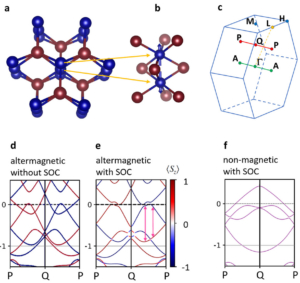A publication with Libor Šmejkal about the spontaneous formation of altermagnetism from orbital ordering has been published in Physical Review Letters.
Altermagnetism has emerged as a third type of collinear magnetism. In contrast to standard ferromagnets and antiferromagnets, altermagnets exhibit extra even-parity wave spin order parameters resulting in a spin splitting of electronic bands in momentum space. In real space, sublattices of opposite spin polarization are anisotropic and related by rotational symmetry. In the hitherto identified altermagnetic candidate materials, the anisotropies arise from the local crystallographic symmetry. Here, they show that altermagnetism can also form as an interaction-induced electronic instability in a lattice without the crystallographic sublattice anisotropy. They provide a microscopic example of a two-orbital model showing that the coexistence of staggered antiferromagnetic and orbital order can realize robust altermagnetism. They quantify the spin-splitter conductivity as a key experimental observable and discuss material candidates for the interaction-induced realization of altermagnetism.








